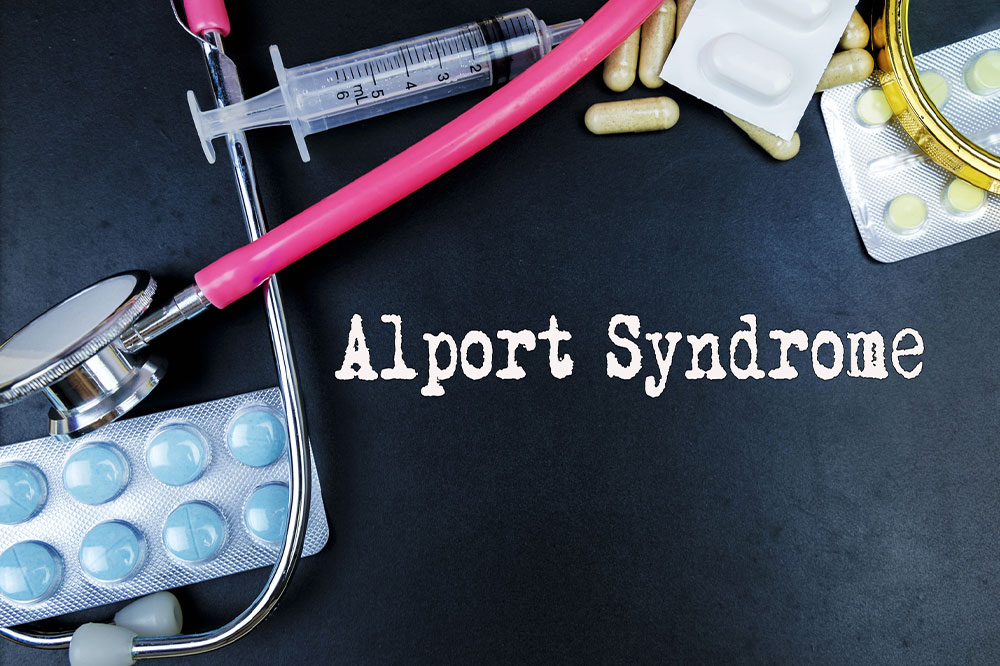Alport syndrome – Causes, signs, and management
Alport syndrome is an inherited disorder that causes kidney blood vessels to rupture. It also causes hearing and vision problems. Blood and protein in the urine and hearing and vision loss are the main symptoms of this condition. Alport syndrome may also result in kidney failure. There are three genetic types of this health condition – X-linked Alport syndrome (XLAS), autosomal recessive Alport syndrome (ARAS), and autosomal dominant Alport syndrome (ADAS).
Causes
Alport syndrome is caused by a defect (mutation) in a gene that codes for collagen, a protein found in connective tissue. The condition is uncommon and is brought on by mutations in the COL4A3, COL4A4, and COL4A5 genes. Each of these genes has instructions for producing a particular part of the type IV collagen protein. In particular, glomeruli, a type of kidney structure, serves a vital role in this protein. Glomeruli are groups of specialized blood vessels that produce urine by removing water and waste from the blood. The type IV collagen in glomeruli becomes aberrant due to mutations in these genes, which hinders the kidneys from effectively filtering the blood and allowing blood and protein to enter the urine. Many people with Alport syndrome experience gradual scarring of the kidneys, which ultimately results in kidney failure.
Signs
Eyesight issues, proteinuria, hearing loss, hematuria, and kidney failure are a few common indicators of this condition.
Hearing Loss
Progressive hearing loss, which is not present at birth but forms later in childhood or early adolescence, is the most common form of hearing loss in patients. Hearing issues may become apparent in some patients around the age of ten. In this type of hearing problem, the hair cells in the cochlea or the nerves involved in hearing are damaged. People with the condition are less likely to be able to hear high tones. Hearing loss worsens over time, causing significant damage that must be rectified with a hearing aid.
Proteinuria
Proteinuria, or protein in the urine, is another vital indicator of Alport syndrome. Here, the protein from the blood is passed into the urine, which is unusual and indicates that the kidneys are not functioning correctly. Apart from possible frothing of the urine, there are no obvious symptoms. Proteinuria is typically diagnosed using a dipstick or lab tests.
Eyesight issues
With Alport syndrome, the shape of the eye lens might change over time. It could eventually take on a cone form, leading to short-sightedness (myopia). In extreme circumstances, the patient might have to replace their eye lenses. The tissues of the retina might have an unusual coloring, which is another sign. It may appear as white specks on the retina’s edge and in the macula’s vicinity. However, the patient’s vision is unaffected by this condition.
Hematuria
One of the main symptoms of Alport syndrome is hematuria, or blood in the urine. Patients may show signs of this dating back to their early adult or childhood years. It is frequently diagnosed when the patient has a minor ailment, such as a cold or a cough. Hematuria can be present in larger concentrations, causing the urine to be pink, crimson, or dark in color, or it can be present in tiny amounts that are hardly noticeable. When a young patient has this condition, it is not usually visible all the time, but only appears when other health conditions cause the same symptom.
Kidney failure
Chronic kidney disease (CKD) appears as your kidney function starts declining. Most patients don’t show signs of CKD until they have renal failure. Symptoms of kidney failure include swelling, particularly in the hands or ankles, extreme fatigue, vomiting and nausea, and muscle pain.
Treatment
Though there is no definitive cure for Alport syndrome, health experts suggest specific remedies that help slow down kidney deterioration and thereby delay renal failure. Some standard treatment options are listed below.
Angiotensin-converting enzyme (ACE) inhibitors
ACE inhibitors help to preserve your kidneys, control blood pressure, and reduce protein in the urine. After diagnosis, men with XLAS or anyone with ARAS should start taking ACE inhibitors. Women with XLAS or ADAS should take ACE inhibitors as soon as protein starts to show up in their urine or even after being diagnosed.
Angiotensin II receptor (ARBs) Blockers
ARBs are advantageous and comparable to ACE inhibitors, however, ARBs are often suggested than ACE inhibitors due to fewer side effects.
Sodium-glucose transporter type 2 (SGLT-2) inhibitors
SGLT-2s can lower your chance of developing kidney failure if you have CKD or Alport syndrome. Your doctor might supplement your ACE inhibitor or ARB with these inhibitors. However, not all SGLT-2 inhibitors are approved by the Food and Drug Administration (FDA) to treat CKD. Additionally, if your glomerular filtration rate is too low, your doctor won’t prescribe them.
Regulated sodium intake
Keeping your blood pressure down and maintaining kidney and heart function can be achieved by reducing the quantity of salt and sodium in your nutritional plan.
Besides these treatment options, hearing aids are a good management tool for hearing problems. As required, eye issues are also treated. For instance, an aberrant lens brought on by lenticonus or cataracts can be changed. However, given that the condition is inherited, genetic counseling may be suggested.

